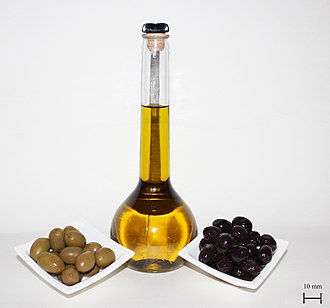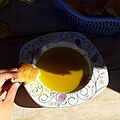Olive oil
Olive oil is a liquid fat obtained from olives, a traditional tree crop of the Mediterranean Basin. It is commonly used in cooking, cosmetics, and pharmaceuticals. Olive oil has been an important ingredient in Mediterranean cuisine for thousands of years. Today, it is used worldwide and is known for its health benefits and distinctive flavor.

History[edit]
Olive oil has a long history dating back to ancient times. The first recorded olive oil production occurred in ancient Greece, around 2500 years ago. Olive oil was used for cooking, lamp fuel, and as a medicinal ointment. The Romans also used olive oil extensively, and it became a staple ingredient in Mediterranean cuisine.
Production[edit]
Olive oil is produced by pressing whole olives. The quality and flavor of the oil depend on many factors, including the variety of olives used, the climate, and the processing methods. Extra-virgin olive oil, the highest quality and most flavorful type of olive oil, is made using only mechanical means without any chemical treatment.
Types[edit]
There are several types of olive oil, including:
Extra-virgin olive oil: This is the highest quality and most flavorful type of olive oil. It is made using only mechanical means without any chemical treatment. It has a low acidity level and a fruity, slightly bitter taste.

Virgin olive oil: This is also made using only mechanical means but has a higher acidity level and a milder flavor than extra-virgin olive oil.

Pure olive oil: This is a blend of extra-virgin and virgin olive oils that have been chemically refined to remove any defects. It has a mild flavor and is suitable for cooking.
Olive pomace oil: This is made from the pulp that remains after the first press of the olives. It is chemically extracted and refined, resulting in a low-quality oil that is often used for industrial purposes.
Health benefits[edit]
Olive oil is known for its numerous health benefits. It is high in monounsaturated fatty acids, which can help reduce the risk of heart disease and stroke. It also contains antioxidants, which can help protect the body against damage from free radicals. Some studies have suggested that olive oil may also have anti-inflammatory and anti-cancer properties.
Culinary uses[edit]
Olive oil is a versatile ingredient that can be used in a wide range of dishes, from salads and pasta to grilled meats and vegetables. Extra-virgin olive oil is best used in dishes that require a strong, fruity flavor, such as dressings and marinades. Pure olive oil is a good choice for sautéing, roasting, and baking, as it has a milder flavor that won't overpower other ingredients.
Culinary uses (continued)[edit]
In Mediterranean cuisine, olive oil is often used as a condiment for dipping bread or drizzling over grilled meats and vegetables. It is also a key ingredient in traditional dishes like Greek salad, Italian pasta, and Spanish paella.
When cooking with olive oil, it is important to choose the right type of oil for the dish. Extra-virgin olive oil is best for dishes that require a strong, fruity flavor, such as salad dressings and marinades. It should not be used for high-heat cooking as it has a low smoke point and can become bitter when heated. Pure olive oil, on the other hand, has a milder flavor and a higher smoke point, making it a good choice for sautéing, roasting, and baking.
Cosmetic and medicinal uses[edit]
Olive oil is not only a popular cooking ingredient but is also used in cosmetics and medicinal ointments. Due to its high content of vitamins A and E, olive oil is a common ingredient in skincare products, such as soaps, creams, and lotions. It is also used as a carrier oil for essential oils in aromatherapy. In traditional medicine, olive oil has been used to treat a variety of ailments, including ear infections, constipation, and skin conditions.
Sustainability[edit]
The production of olive oil has both environmental and social impacts. Olive trees are long-lived and drought-resistant, making them a sustainable crop in arid regions. However, the intensive use of water and pesticides in some olive-growing regions can have negative impacts on the environment. In addition, the labor-intensive process of harvesting olives can lead to poor working conditions and low wages for workers.
Conclusion[edit]
Olive oil is a versatile and flavorful ingredient that has been used in Mediterranean cuisine for thousands of years. With its numerous health benefits and culinary uses, it has become a popular ingredient in kitchens worldwide. Whether used as a condiment, cooking oil, or cosmetic ingredient, olive oil is an essential part of many cultures and cuisines.
Grades of olive oils[edit]
- U.S. Extra Virgin Olive Oil is virgin olive oil has the free fatty acid called oleic acid, of not more than 0.8 grams per 100 grams. The extra virgin olive oil is considered the healthiest of the various varieties of olive oil.
- U.S. Virgin Olive Oil is virgin olive oil has oleic acid, of not more than 2.0 grams per 100 grams.
- U.S. Virgin Olive Oil Not Fit For Human Consumption Without Further Processing sometimes designated as “U.S. Lampante Virgin Olive Oil,” is virgin olive oil which has poor flavor and odor with free fatty acid content, expressed as oleic acid, of more than 2.0 grams per 100 grams.
- U.S. Olive Oil is the oil consisting of a blend of refined olive oil and virgin olive oils fit for consumption without further processing with free fatty acids (oleic acid), of not more than 1.0 gram per 100 grams.
- U.S. Refined Olive Oil is the olive oil obtained from virgin olive oils with a free fatty acid content, expressed as oleic acid, of not more than 0.3 grams per 100 grams
-
Harvesting olives
-
Olives
-
Olives of different types and color
-
Ancient oil press
-
Oil press, Punat, Croatia
-
Olive oil
-
Olive oil in cooking
-
Olives in olive oil
-
Olive oil and honey
-
Olive oil with balsamic vinegar
Which olive oil is healthier?[edit]
In general, the more refined extra virgin olive is considered better for health as it has less saturated fat.
How is olive oil obtained?[edit]
Olive oil is obtained by pressing the ripe olives, a tree crop of the Mediterranean, in a traditional press. It is one of the very few oils obtained without any chemical processing and is used in cooking and as a salad dressing.
Potential Health Benefits[edit]
Extra virgin olive oil (EVOO) consumption is able to reduce lipid and DNA oxidation, ameliorate lipid profile and insulin-resistance, endothelial dysfunction, inflammation, and to lower blood pressure in hypertensive patients. These effects protect from both cardiovascular disease and metabolic disorders.
| Edible fats and oils | ||||||||||||||||||||
|---|---|---|---|---|---|---|---|---|---|---|---|---|---|---|---|---|---|---|---|---|
; See also
|
| Olives | ||||
|---|---|---|---|---|
|
| Salad dressings | ||||||
|---|---|---|---|---|---|---|
|
| Mediterranean cuisine | ||||||
|---|---|---|---|---|---|---|
* Category
|
Ad. Transform your life with W8MD's Budget GLP-1 injections from $75


W8MD offers a medical weight loss program to lose weight in Philadelphia. Our physician-supervised medical weight loss provides:
- Weight loss injections in NYC (generic and brand names):
- Zepbound / Mounjaro, Wegovy / Ozempic, Saxenda
- Most insurances accepted or discounted self-pay rates. We will obtain insurance prior authorizations if needed.
- Generic GLP1 weight loss injections from $75 for the starting dose.
- Also offer prescription weight loss medications including Phentermine, Qsymia, Diethylpropion, Contrave etc.
NYC weight loss doctor appointmentsNYC weight loss doctor appointments
Start your NYC weight loss journey today at our NYC medical weight loss and Philadelphia medical weight loss clinics.
- Call 718-946-5500 to lose weight in NYC or for medical weight loss in Philadelphia 215-676-2334.
- Tags:NYC medical weight loss, Philadelphia lose weight Zepbound NYC, Budget GLP1 weight loss injections, Wegovy Philadelphia, Wegovy NYC, Philadelphia medical weight loss, Brookly weight loss and Wegovy NYC
|
WikiMD's Wellness Encyclopedia |
| Let Food Be Thy Medicine Medicine Thy Food - Hippocrates |
Medical Disclaimer: WikiMD is not a substitute for professional medical advice. The information on WikiMD is provided as an information resource only, may be incorrect, outdated or misleading, and is not to be used or relied on for any diagnostic or treatment purposes. Please consult your health care provider before making any healthcare decisions or for guidance about a specific medical condition. WikiMD expressly disclaims responsibility, and shall have no liability, for any damages, loss, injury, or liability whatsoever suffered as a result of your reliance on the information contained in this site. By visiting this site you agree to the foregoing terms and conditions, which may from time to time be changed or supplemented by WikiMD. If you do not agree to the foregoing terms and conditions, you should not enter or use this site. See full disclaimer.
Credits:Most images are courtesy of Wikimedia commons, and templates, categories Wikipedia, licensed under CC BY SA or similar.
Translate this page: - East Asian
中文,
日本,
한국어,
South Asian
हिन्दी,
தமிழ்,
తెలుగు,
Urdu,
ಕನ್ನಡ,
Southeast Asian
Indonesian,
Vietnamese,
Thai,
မြန်မာဘာသာ,
বাংলা
European
español,
Deutsch,
français,
Greek,
português do Brasil,
polski,
română,
русский,
Nederlands,
norsk,
svenska,
suomi,
Italian
Middle Eastern & African
عربى,
Turkish,
Persian,
Hebrew,
Afrikaans,
isiZulu,
Kiswahili,
Other
Bulgarian,
Hungarian,
Czech,
Swedish,
മലയാളം,
मराठी,
ਪੰਜਾਬੀ,
ગુજરાતી,
Portuguese,
Ukrainian










